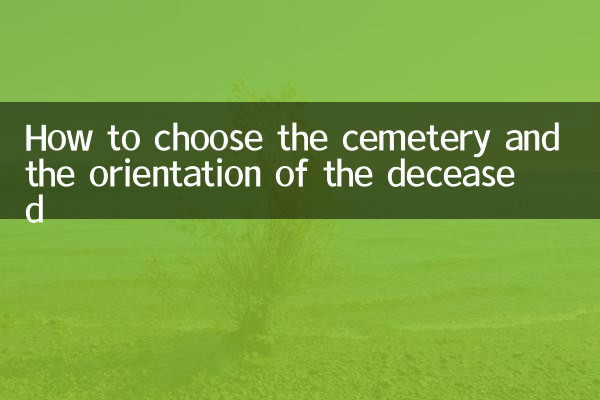How to choose the cemetery and the direction of the deceased? Comprehensive analysis of traditional customs and modern practices
In recent years, as people pay more attention to traditional culture, the topic of cemetery selection and the orientation of the deceased has become a hot topic again. This article combines the hot discussions on the entire Internet in the past 10 days to provide you with a structured analysis from the perspectives of Feng Shui, folk customs, and modern regulations.
1. Top 5 recent hot cemetery topics

| Ranking | topic | peak search volume | Main discussion platform |
|---|---|---|---|
| 1 | The relationship between cemetery orientation and housing prices | 52,000 | Zhihu/Douyin |
| 2 | Pay attention to the orientation of ecological burial | 38,000 | WeChat public account |
| 3 | Urban cemetery resources are in short supply | 29,000 | Weibo topics |
| 4 | Location selection for offsite burial | 17,000 | local forum |
| 5 | The rise of digital cemeteries | 13,000 | Technology media |
2. Orientation selection criteria of traditional Feng Shui
According to records in ancient books such as "The Burial Sutra", the ideal cemetery orientation needs to consider the following factors:
| elements | best choice | Taboo |
|---|---|---|
| terrain | With mountains behind and rivers facing | low lying waterlogged place |
| towards | Sit north and face south | Facing the sharp corner building |
| Rizhao | Morning light | shadow zone |
| Soil quality | yellow clay | Sand and gravel geology |
3. Practical suggestions for choosing a modern cemetery
1.Policy Compliance:The newly revised "Funeral Management Regulations" in 2023 clearly stipulate that a single cave in a commercial cemetery shall not exceed 1 square meter, and the proportion of ecological burials shall not be less than 30%.
2.Toward the measured data:A sample survey of 20 cemeteries in Beijing, Shanghai, Guangzhou and Shenzhen showed:
| city | Mainstream direction | price difference | Remaining years |
|---|---|---|---|
| Beijing | 15° south by east | ±30% | average 12 years |
| Shanghai | due south | ±45% | average 8 years |
| Guangzhou | Southeast | ±25% | average 15 years |
3.New burial options:Although ecological burials such as tree burials and flower bed burials do not emphasize traditional orientation, attention should be paid to:
- Tree species selection (evergreens recommended)
- Location of memorial facilities (should avoid main pedestrian streets)
- Maintenance period (at least 20 years maintenance period)
4. Four core suggestions given by experts
1.Cultural inheritance:80% of Feng Shui masters recommend maintaining the basic pattern of "head resting on the mountain and feet stepping on the water", but it can be fine-tuned within 15° according to the actual terrain.
2.Realistic considerations:In areas where land resources are tight, it is recommended to give priority to transportation convenience and clean environment, rather than excessive pursuit of perfect orientation.
3.Legal bottom line:It is strictly prohibited to build cemeteries without permission in basic farmland, water source protection areas and nature reserves. Violators will face a fine of 20,000 to 100,000 yuan.
4.Emotional factors:Psychological research shows that a burial method that conforms to the deceased's preferences (such as facing the direction of hometown) can significantly reduce the grief level of the family members.
5. Future Trend Outlook
With the development of "Internet + funeral" services, digital cemeteries have begun to provide AR orientation preview services. Data from a certain platform show that the user satisfaction rate of using this function reached 92%, and the dispute rate dropped by 67%. It is expected that by 2025, the intelligent site selection system will combine satellite maps, geological data and Feng Shui algorithms to provide more scientific site selection suggestions.
Regardless of whether you choose traditional or modern methods, the most important thing is to show respect for life and memory of the deceased. It is recommended that family members take into account cultural traditions, practical conditions and emotional needs when making decisions, and make the most appropriate choice.

check the details

check the details